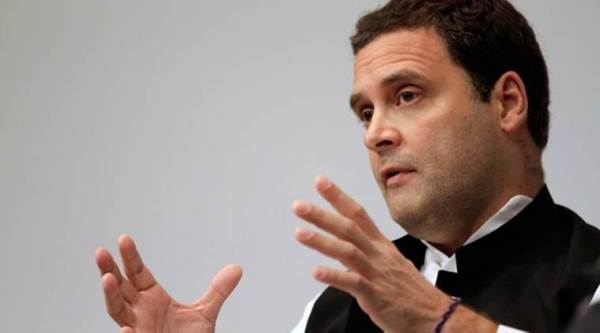 Rahul Gandhi said the Congress and opposition parties were now focused on warding off the onslaught on the Indian constitution and institutions. (Reuters Photo/File)
Rahul Gandhi said the Congress and opposition parties were now focused on warding off the onslaught on the Indian constitution and institutions. (Reuters Photo/File)
Hours after he said the 2019 Lok Sabha elections would be a fight between the BJP on one side and the entire opposition on the other, Congress president Rahul Gandhi set up three key panels for the polls.
The nine-member core committee announced by the party is dominated by the old guard, but does not include UPA chairperson Sonia Gandhi. Rahul also announced a 19-member manifesto committee, and a 13-member publicity committee — the latter has many young faces.
Sonia’s trusted aide and newly appointed AICC treasurer Ahmed Patel, senior leaders A K Antony and P Chidambaram, AICC general secretaries Ghulam Nabi Azad, Ashok Gehlot, Mallikarjun Kharge and K C Venugopal, besides Jairam Ramesh and Randeep Surjewala, are members of the core committee. It is a big leg up for the likes of Surjewala and Venugopal, who were not involved in any planning and strategising in the 2014 campaign.
On Friday night, addressing students at an event at the London School of Economics, Rahul said the 2019 elections were going to be “pretty straightforward” with the “BJP on one side and the entire opposition on the other side”. He said the opposition would go to the people with a “common minimum structure”.
“That is how the next election is going to be. And the reason for that is that almost everybody in the opposition and also members of the BJP alliance feel that the encroachment that is taking place on Indian institutions, the systematic attack that is taking place on Indian institutions… So there is a feeling in the opposition that for the first time, an organisation is challenging the very conception of India and this has not happened in the last 70 years,” he said.
“So there is this move that we need to defend the Indian institutions, we need to defend the idea of one man one vote; we need to defend the inclusive idea of India. And you’re going to have a clear cut election where everybody is going to be on one side and the RSS/BJP is going to be on the other side and once that math starts to come into play, and you can look at the UP and Bihar alliances as sort of the central focus areas, it becomes very difficult for the BJP to win elections,” he said.
The 19-member manifesto committee includes Punjab Finance Minister Manpreet Badal, Sushmita Dev, Rajeev Gowda, Bindu Krishnan, Raghuveer Meena, Balchandra Mungekar, Rahul’s close aide Sachin Rao, Lalitesh Tripathi, and Rajni Patil, besides seniors like Chidambaram, Bhupinder Singh Hooda, Jairam Ramesh, Salman Khurshid, Shashi Tharoor and Kumari Selja. Former Meghalaya chief minister Mukul Sangma, Tamradhwaj Sahu, Meenakshi Natarajan, and Sam Pitroda too, are on the panel.
The publicity committee has Surjewala, former ministers Anand Sharma, Manish Tewari and Rajeev Shukla, besides Bhakta Charan Das, Praveen Chakravarty, Milind Deora, Kumar Ketkar, Pawan Khera, VD Satheesan, Jaiveer Shergill, the party’s social media head Divya Spandana, and former Rajya Sabha member Pramod Tiwari.
Rahul, during his talk at the LSE, argued that the party cannot ignore the seniors as there is a lot of value in some of them. “…The present has to be a merger of the future and the past and that’s really why the Congress ran into trouble in 2014 because we found that there was a internal fight taking place between the older generation and the younger generation and a lot of the work we’ve done now is try and bring them together successfully.”
Rahul interestingly identified “arrogance” as a threat in the Congress when asked to do a SWOT analysis of the Congress party in the context of the 2019 elections.
On the Prime Ministerial question, Rahul said the Congress and opposition parties were now focused on warding off the onslaught on the Indian constitution and institutions.
“So we’ve agreed that our first priority is to defeat the BJP and stop this encroachment on the institutional space of India, stop the poison that is being spread, stop the division that is taking place. Once the election is over, all those conversations can be had but we’re not going to have those conversations until we have done the first stage which is to remove the BJP from power. That is the nature of the conversation,” he said.
He said while the Congress is drawing up a manifesto “looking into a lot of the ideas” and discussing with and meeting stakeholders and others, “we’re also talking to allies on what that framework would look like and so potentially we would have a structure that we go to the Indian people with the common minimum structure.”